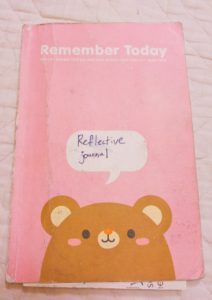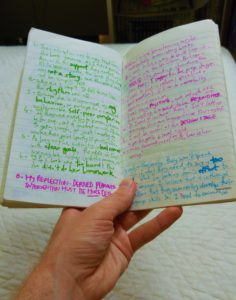 By Stewart Gray
By Stewart Gray
If you’re like me, you’re one of the many teachers who live with the fear of one day settling firmly and conclusively into a teaching routine, never to improve, experiment, or learn much of anything again. Well, the end to our anxieties is at hand; we have only to reach for a small notebook, and perhaps some colored pens.
I first encountered the practice of reflective journaling at a Reflective Practice meeting in Seoul, a gathering for teachers interested in sharing their experiences and concerns, and collaborating in the process of reflecting on their teaching. At this meeting, it seemed to me that the other teachers in attendance, cool as they were, had already been journaling for years. The idea was pitched to me as a personalized means of engaging in reflective practice: you keep a journal, be it paper or electronic, in which you jot down your observations and musings after each (and ideally every) class, and based on these writings you make plans to improve areas in your practice you find to be lacking. Then you can make those changes, see how they go, make further notes, plan further changes, and proceed in this fashion until you hit mandatory retirement age.
As a result of that meeting, I became convinced that reflective journaling was the solution to the problem of my afore-mentioned anxiety about professional stagnation. With a new semester looming, and gripped somewhat by a desperate desire to seize the reigns of my own professional development, I went out at once and purchased a small, pink notebook, on the cover of which I scribbled ‘reflective journal.’ What follows is an excerpt from my first ever reflective writing which I noted down after finishing that semester’s first class:
Aug 24 – Class was quite boring. Too much talking from me, all-round. This frustrates me. HOW CAN I STEP OUT OF THE LIMELIGHT? (Caps in original)

It was an inauspicious start but, crucially, I had started, and so I proceeded to make notes regularly after class throughout the semester. At that point I had received one piece of advice about the content of reflective notes (from Chris Miller, of Daeil High School) that had really stuck – that it makes sense to push myself to write a certain minimum length, say, eight lines per entry. As the weeks wore on, though, I was able to refine my technique considerably thanks to conversations with many sage, introspective teachers, who shared with me the wisdom I shall now share alike:
1 – Try to make initial, observational notes as objective as possible. At first, write down what you saw, heard, felt, describe the organization of the classroom, what the students did and when; only then commit to expressing feelings and judgments about the meaning of what happened. If instead you begin your reflections with “That class was so terrible,” you may miss something valuable in your haste.
2 – Try Kolb’s cycle. Kolb’s is a simple, four-stage format for organizing the process of reflective thinking which I use in my own journaling: 1. Making objective observations of in-class phenomena; 2. Contemplating the reasons for those phenomena occurring; 3. Considering the implications of all of this; 4. Making plans for a change. I always write the different stages in different colored ink, for ease of visual organization, for example:
May 27 – Students spoke English with surprising confidence in the partner activity. (Black)
–> Maybe the example questions on the board helped, and maybe they’re getting used to this type of speaking activity over time. (Green)
–> I should provide visual assistance (examples) to support speaking activities. (Pink)
–> Before the discussion in the next class, I will work through a few examples with them on the board. (Light blue)

3 – Collaborate on reflection. Once you’ve got a journal going, there’s no obligation to keep its contents to yourself. Participating in a group of reflective teachers in person or online can help to keep you accountable for your reflections and improve your approaches. This has certainly been my experience; everything I know about reflection I got from the advice and shared experiences of others.
If any of the above ideas appeal, I wholeheartedly recommend giving them a try. Perhaps, though, you are thinking that color pens and reflective group meetings are not your style, or that Kolb’s cycle seems a bit restrictive. Not to worry, for whether you prefer to do things by yourself, in your own way, or exclusively in black ink, journal writing can still provide great benefits to your practice. For me, it has provided a greater sense of control over the direction of my ongoing professional development, a means to respond to challenges in my teaching practice as and when I encounter them, and a valuable record of my past teaching experiences. I only hope I can keep it up until retirement.
Happy journaling.


I really enjoyed reading your blog. It is as if you had put my own thoughts in your own words. Excellent work!
Dear Stewart Gray,
I’d like to know if you could provide me with a facebook group on reflective teaching. I’m so interested to join. Thank YOU!
Hi Mongia,
Glad to hear you enjoyed this post. I’m sorry to say, I’m not in a position to suggest many RP Facebook groups, except this one for teachers in Korea:
https://m.facebook.com/profile.php?id=310920115682670&ref=content_filter
That’s not so much a group for doing RP as for sharing resources. At any rate, I hope it’s helpful!
No worries!Thank you so much.